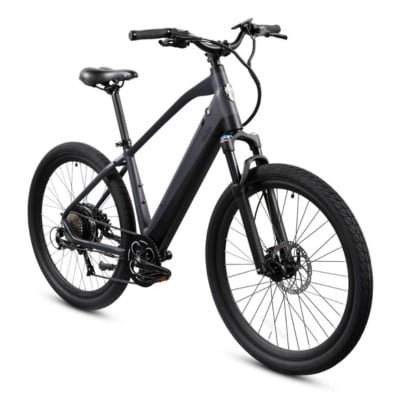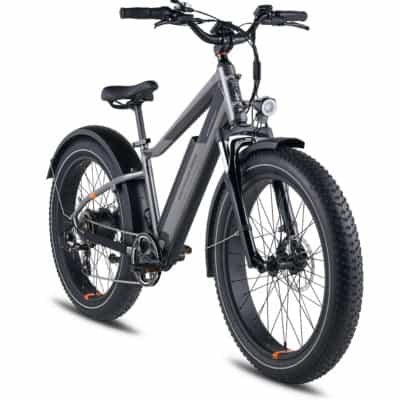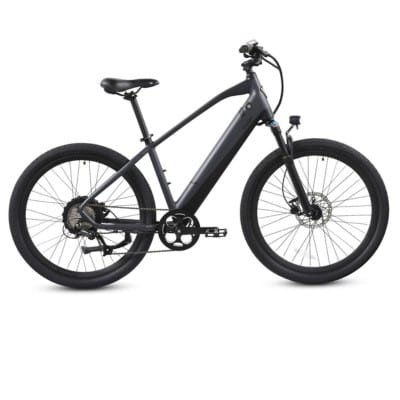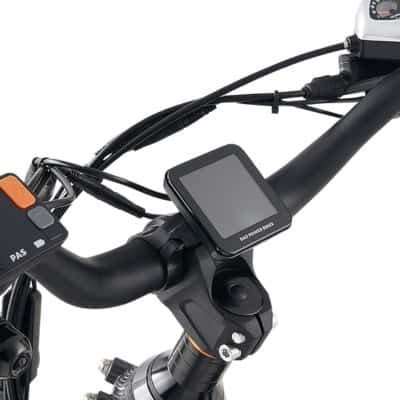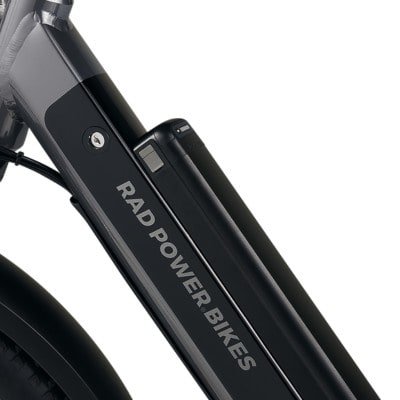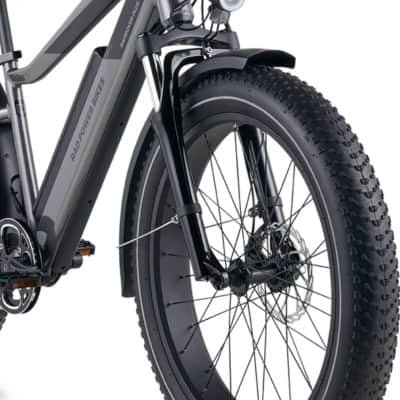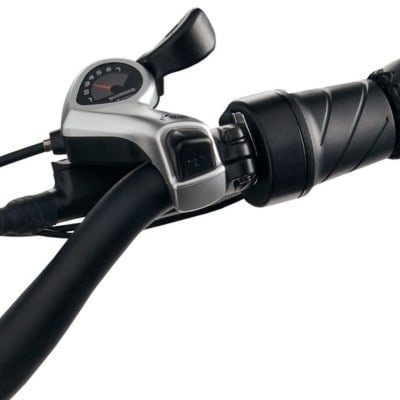When it comes to electric bikes, the Ride1Up LMT'D and RadRover 6 Plus are two popular options on the market. Both bikes offer powerful motors, long battery life, and a comfortable ride. However, there are some key differences between the two that may influence your decision on which one to choose.
One of the biggest differences between the Ride1Up LMT'D and RadRover 6 Plus is their design. The Ride1Up LMT'D has a sleeker, more modern look with a thinner frame and integrated battery. Meanwhile, the RadRover 6 Plus has a more traditional, bulky design with a semi-integrated battery and fat tires. This difference in design may be a deciding factor for those who prioritize aesthetics.
Another important factor to consider is the performance of each bike. The Ride1Up LMT'D has a 750W motor and can reach speeds up to 28 mph, while the RadRover 6 Plus has a 750W motor and can reach speeds up to 20 mph. Additionally, the Ride1Up LMT'D has a range of up to 50 miles on a single charge, while the RadRover 6 Plus has a range of up to 45 miles. These differences in speed and range may be important for those who plan to use their electric bike for commuting or longer rides.
VS
Appearance & Design
The Ride1up LMT'D and RadRover 6 Plus both have unique designs that cater to different types of riders.
The Ride1up LMT'D has a sleek and modern design available in both step-over and step-through frame designs. It is available in two colors, Midnight Gray and Sandstone, and features a color display that provides essential information such as speed, battery life, and distance traveled. The lightweight alloy frame of the Ride1up LMT'D makes it easy to maneuver and transport.
On the other hand, the RadRover 6 Plus has a more rugged and durable appearance, with fat tires and a sturdy frame. It is available in two colors, Charcoal and Glossy white, and features an LCD display and a control pad that provides detailed information about the bike's performance. The RadRover 6 Plus is designed for off-road adventures and can handle rough terrain with ease.
Overall, both bikes have high-quality designs that cater to different types of riders. The Ride1up LMT'D is perfect for commuters who want a lightweight and easy-to-use bike, while the RadRover 6 Plus is ideal for those who want to explore off-road trails and rugged terrain.
Display and Controls
The Ride1up LMT'D eBike comes with a color LCD display that is easy to read and navigate. It shows all the necessary information such as speed, battery life, distance traveled, and more. The display also has a backlight, making it easy to read in low light conditions. The controls are conveniently located to the left side of the screen and include a thumb throttle, which allows us to easily control the speed of the bike.
On the other hand, the RadRover 6 Plus comes with an adjustable speed LCD display. It is also easy to read and provides all the necessary information such as speed, battery life, and distance traveled. The controls are located on a different pad to the left of the handlebars and include a cadence sensor, which helps us maintain a consistent speed while pedaling.
Overall, both eBikes have great displays and controls that make it easy to navigate and control the bike. The Ride1up LMT'D eBike has a color display and throttle, while the RadRover 6 Plus has an adjustable speed LCD display and cadence sensor.
Weight and Weight Limits
The Ride1up LMT'D eBike weighs in at 53 lbs, making it a relatively lightweight option for an eBike. In comparison, the RadRover 6 Plus is a bit heavier, weighing in at 73.4 lbs. This extra weight can make it more difficult to maneuver and transport.
Another important consideration is weight limits. The Ride1up LMT'D eBike has a weight capacity of 300 lbs, which is impressive for a bike of its size. This means that it can accommodate a wide range of riders, both large and small. The RadRover 6 Plus, on the other hand, has a weight capacity of 275 lbs, which may not be suitable for larger riders.
It's important to note that weight limits are not just about the weight of the rider, but also the weight of any cargo that may be carried on the bike. Both the Ride1up LMT'D eBike and the RadRover 6 Plus offer cargo racks as an optional accessory, but it's important to stay within the weight limits to ensure safe and optimal performance.
Overall, the Ride1up LMT'D eBike is a great option for those who value a lightweight and versatile eBike with a high weight capacity. The RadRover 6 Plus may be a better choice for those who prioritize off-road capabilities and don't mind a heavier bike.
Motor & Power
In this section, we will compare the motor and power of the Ride1up LMT'D eBike and the RadRover 6 Plus.
The Ride1up LMT'D eBike boasts a powerful 750 watt continuous rear hub motor with about 80 Nm of torque. This motor provides a smooth and powerful ride, allowing us to tackle steep hills and rough terrain with ease. The rear hub motor design also provides a more balanced weight distribution, resulting in better handling and control.
On the other hand, the RadRover 6 Plus features a 750 watt geared hub motor, which is located in the rear wheel. While this motor provides decent power and acceleration, it may not be as smooth or efficient as a mid-drive design. Additionally, the geared hub motor may require more maintenance and repairs over time.
The Ride1up LMT'D eBike's higher top speed makes it an attractive choice for riders seeking an extra burst of speed and excitement during their journeys. On the other hand, the RadRover 6 Plus, while decent in performance, may not deliver the same level of speed and thrill as the Ride1up LMT'D eBike.
Overall, both eBikes feature a similar power rating of 750W. However, the Ride1up LMT'D eBike stands out with a top speed of 28mph, providing a faster and more exhilarating ride. In contrast, the RadRover 6 Plus is limited to a top speed of 20mph.
Battery Capacity and Range
The RadRover 6 Plus features a 48V semi-integrated battery with a capacity of 672Wh. According to RadPowerBikes, the battery can provide a range of 25-45 miles, depending on the PAS level and rider weight. In our experience, we found the battery to be quite reliable and long-lasting. We were able to cover a distance of around 35 miles on a single charge, which is impressive.
On the other hand, the Ride1up LMT'D comes with a 48V 14Ah battery with a capacity of 672Wh. The company claims that the battery can provide a range of up to 50 miles on a single charge. In our experience, we found the battery to be quite powerful and long-lasting. We were able to cover a distance of around 40 miles on a single charge, which is impressive.
In terms of battery capacity and range, both Ride1up LMT'D eBike and RadRover 6 Plus are quite similar. However, we found the Ride1up LMT'D eBike to have a slightly better range than the Radrover 6 Plus. Nonetheless, both eBikes are suitable for commuting and long-distance rides.
Overall, we were satisfied with the battery capacity and range of both eBikes. They are both reliable and long-lasting, providing a decent range on a single charge.
Ride Quality & Handling
We found the Ride1up LMT'D eBike and RadRover 6 Plus to have different ride qualities and handling characteristics.
The Ride1up LMT'D has a smoother ride quality on both asphalt and off-road trails due to its suspension fork and seat post. It handles well on both terrains, although we did notice some slight wobbling at higher speeds on off-road trails. The torque sensor on the LMT'D provides a consistent and smooth pedal-assist experience.
On the other hand, the RadRover 6 Plus doesn't provide as much suspension as the Ride1up LMT'D. It handles well on asphalt but can be a bit bumpy on off-road trails. The cadence sensor on the RadRover 6 Plus provides a decent pedal-assist experience, but we did notice some lag in the motor response.
For commuting purposes, we prefer the Radrover 6 Plus due to its smoother ride quality and consistent pedal-assist experience. However, for off-road adventures, the Ride1up LMT'D can handle the terrain better due to its better suspension.
Overall, both eBikes have their strengths and weaknesses in terms of ride quality and handling. It ultimately comes down to personal preference and intended use.
Suspension, Brakes, Wheels & Tires
Starting with the suspension, the Ride1up LMT'D has a front suspension fork with 80mm of travel, while the RadRover 6 Plus has a front suspension fork with 60mm of travel. Both suspension systems do an excellent job of absorbing bumps and providing a comfortable ride.
Moving on to the brakes, both bikes have hydraulic disc brakes, which provide excellent stopping power and are easy to modulate. The Ride1up LMT'D has Tektro hydraulic disc brakes with 180mm rotors, while the RadRover 6 Plus also has hydraulic disc brakes with 180mm rotors.
In terms of wheels and tires, the Ride1up LMT'D has WTB Groov-e tires, which are known for their excellent grip and durability. The RadRover 6 Plus has Kenda Juggernaut tires, which are also highly regarded in the eBike community. The Radrover 6 Plus has 26-inch wheels, which provide a stable and comfortable ride while the Ride1up LMT'D comes with 27.5-inch tires.
Overall, both the Ride1up LMT'D and the RadRover 6 Plus have impressive suspension, brakes, wheels, and tires. It ultimately comes down to personal preference, but riders can rest assured that both bikes are equipped with high-quality components that will provide a smooth and safe ride.
VS
Pedal Assist & Throttles
Pedal assist, also known as PAS, uses sensors to detect when you are pedaling and provides assistance accordingly. Throttle, on the other hand, allows you to control the motor with a hand grip or thumb lever, without the need for pedaling.
The Ride1up LMT'D and RadRover 6 Plus both offer both pedal assist and throttle options. The LMT'D is a class 3 electric bike, which means it can reach speeds of up to 28mph with pedal assist and 20mph with throttle. The RadRover 6 Plus, on the other hand, is a class 2 electric bike, which means it can reach speeds of up to 20mph with both pedal assist and throttle.
We found that both bikes offer smooth and responsive motor assistance, regardless of whether we were using pedal assist or throttle. The LMT'D's torque sensing motor provided a more natural and intuitive riding experience, while the RadRover 6 Plus's cadence sensing motor required a bit more effort to get going.
One thing to note is that throttle-only operation can drain the battery faster than pedal assist. However, we found that both bikes had decent battery life, with the LMT'D offering up to 50 miles of range on a single charge and the RadRover 6 Plus offering up to 45 miles with pedal assist and up to 25 miles with throttle.
Overall, we found that both bikes offered reliable and enjoyable motor assistance, whether we were looking for a quick boost or a more leisurely ride. The LMT'D's class 3 status and torque sensing motor make it a great option for those looking for a high-performance electric bike, while the RadRover 6 Plus's entry-level price point and versatile class 2 status make it a solid choice for those looking for a more casual ride.
Portability
The Ride1up LMT'D features a small, lightweight alloy frame that makes it easy to transport. Weighing in at just under 53 pounds, it's not the lightest eBike on the market, but it's still manageable for most people.
On the other hand, the RadRover 6 Plus is a lot heavier, weighing around 73.4 pounds. However, it also has a small, lightweight alloy frame that makes it easy to maneuver. One downside to the RadRover 6 Plus is that it doesn't have folding handlebars, which can make it more difficult to store or transport.
Both eBikes are designed to be ridden off-road, so they come equipped with fat tires that can handle rough terrain. However, the wider tires on the RadRover 6 Plus can make it more difficult to fit in tight spaces, such as the trunk of a car.
Overall, both eBikes are relatively portable and easy to transport. The Ride1up LMT'D has the advantage of a lighter frame, while the RadRover 6 Plus has the advantage of a more rugged design. Ultimately, the choice between the two will come down to personal preference and intended use.
Pros & Cons Ride1up LMT'D vs RadRover 6 Plus
Let's take a closer look at the benefits and drawbacks of the Radrover 6 Plus and the Ride1up LMT'D;
Pros of Ride1up LMT'D
Cons of Ride1up LMT'D
Pros of RadRover 6 Plus
Cons of RadRover 6 Plus
Overall, both the Ride1up LMT'D and the RadRover 6 Plus offer unique advantages and disadvantages. It ultimately comes down to personal preference and specific needs when choosing between the two.
Specifications and Features Table
To help you compare the Ride1Up LMT'D eBike and the RadRover 6 Plus, we've put together a table of their specifications and features.
Specification/Feature | Ride1Up LMT'D | RadRover 6 Plus |
|---|---|---|
Lights | Front lights | Front and rear LED lights |
Price | Expensive | Affordable |
Top Speed | 28 mph | 20 mph |
Battery | 48V 14ah | 48V 14ah |
Suspension | Air suspension fork | Hydraulic suspension fork |
Brakes | 180mm hydraulic disc brakes | 180mm hydraulic disc brakes |
Tires | 27.5"x2.4" | 26"x4" |
Motor Power | 750W | 750W |
Rear Rack | Optional | Optional |
Fenders | No | Yes |
Color Options | Two; Charcoal and Glossy white | Two; Midnight gray and Sandstone |
Gears | 8-speed gear | 7-speed gear |
Weight | 53 lb | 73.4 lb |
Weight Limit | 300 lb | 275 lb |
Both the Ride1up LMT'D and the RadRover 6 Plus are equipped with robust 750W motors, ensuring ample power for your riding needs.
When it comes to speed, the Ride1up LMT'D takes the lead with an impressive top speed of 28mph. In contrast, the RadRover 6 Plus offers a slightly lower top speed at 20mph.
Safety is paramount, and both of these eBikes feature hydraulic disc brakes, providing reliable and efficient stopping power in various riding conditions.
There's a distinction in how these bikes integrate their batteries. The Ride1up LMT'D boasts an integrated battery seamlessly incorporated into its frame, while the RadRover 6 Plus features a semi-integrated battery.
Tire size can significantly impact your riding experience. The Ride1up LMT'D sports 27.5"x2.4" tires, striking a balance between stability and agility. On the other hand, the RadRover 6 Plus features larger 26x4" tires, perfect for tackling diverse terrain with enhanced traction and stability.
These specifications provide valuable insights into what each eBike has to offer. The Ride1up LMT'D excels in terms of top speed, while the RadRover 6 Plus shines with its sturdy semi-integrated battery and fat tires. Your choice between the two will ultimately depend on your riding preferences and the terrain you plan to conquer.
Overall Recommendation Based on Intended Use
After extensively testing both the Ride1up LMT'D eBike and the RadRover 6 Plus, we have come to our overall recommendation based on intended use.
For those who prioritize quality and performance in their electric bikes, we recommend the Ride1up LMT'D eBike. The components of the LMT'D, including the 8-speed drivetrain and air suspension fork, make it a top-tier choice for commuting and off-road adventures alike. The tires also provide excellent traction and stability, while the moped-style design adds a unique touch of style.
On the other hand, for those who prioritize versatility and utility, we recommend the RadRover 6 Plus. It's rugged design and fat tires make it an ideal choice for riding on various types of terrain. The RadRover 6 Plus is also a great option for those who prioritize assembly and ease of use.
Overall, both manufacturers offer excellent e-bikes with unique strengths. We recommend the Ride1up LMT'D for those who prioritize performance and the RadRover 6 Plus for those who prioritize utility and versatility.
VS

